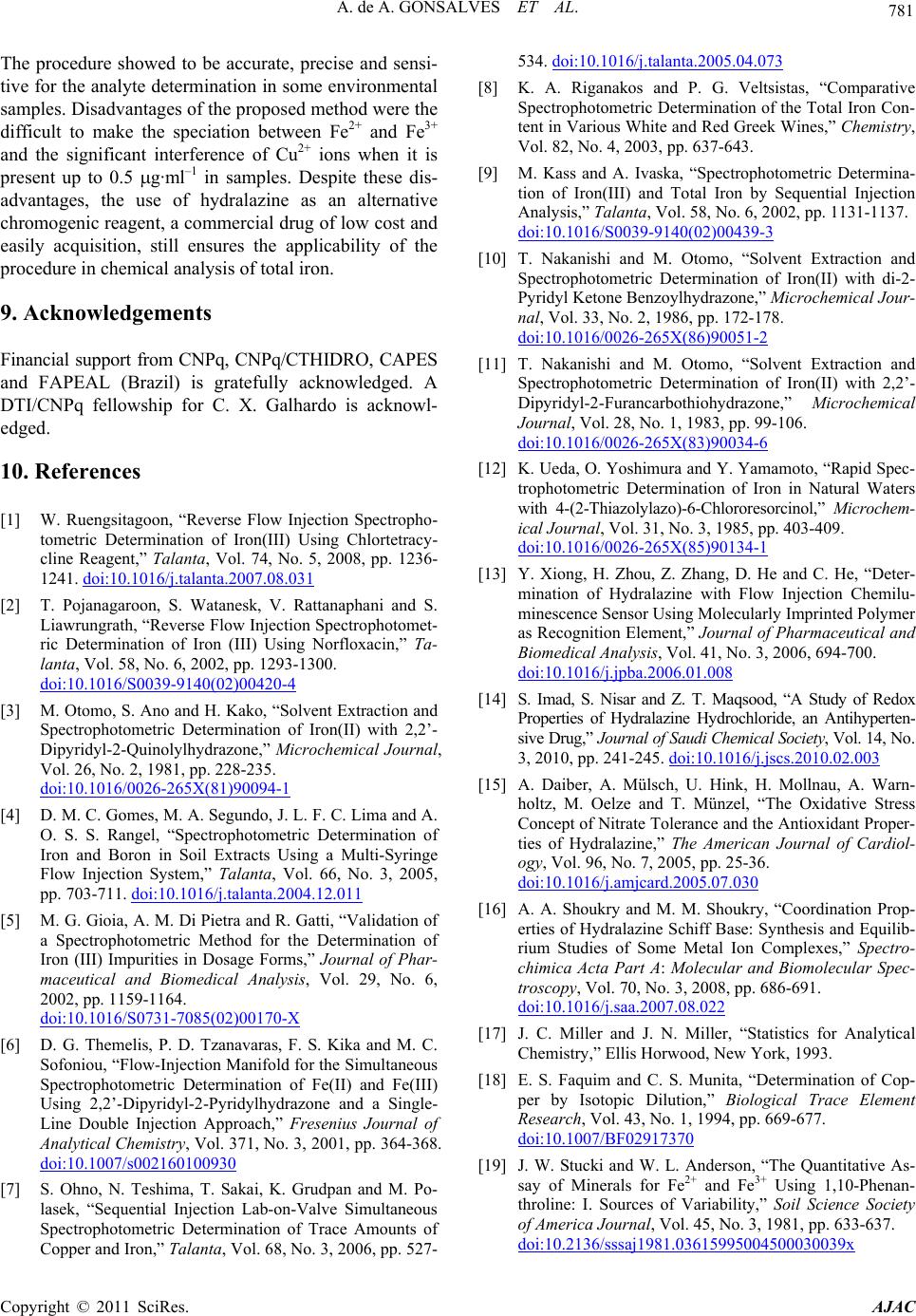
781
A. de A. GONSALVES ET AL.
The procedure showed to be accurate, precise and sensi-
tive for the analyte determination in some environmental
samples. Disadvantages of the proposed method were the
difficult to make the speciation between Fe2+ and Fe3+
and the significant interference of Cu2+ ions when it is
present up to 0.5 g·ml–1 in samples. Despite these dis-
advantages, the use of hydralazine as an alternative
chromogenic reagent, a commercial drug of low cost and
easily acquisition, still ensures the applicability of the
procedure in chemical analysis of total iron.
9. Acknowledgements
Financial support from CNPq, CNPq/CTHIDRO, CAPES
and FAPEAL (Brazil) is gratefully acknowledged. A
DTI/CNPq fellowship for C. X. Galhardo is acknowl-
edged.
10. References
[1] W. Ruengsitagoon, “Reverse Flow Injection Spectropho-
tometric Determination of Iron(III) Using Chlortetracy-
cline Reagent,” Talanta, Vol. 74, No. 5, 2008, pp. 1236-
1241. doi:10.1016/j.talanta.2007.08.031
[2] T. Pojanagaroon, S. Watanesk, V. Rattanaphani and S.
Liawrungrath, “Reverse Flow Injection Spectrophotomet-
ric Determination of Iron (III) Using Norfloxacin,” Ta-
lanta, Vol. 58, No. 6, 2002, pp. 1293-1300.
doi:10.1016/S0039-9140(02)00420-4
[3] M. Otomo, S. Ano and H. Kako, “Solvent Extraction and
Spectrophotometric Determination of Iron(II) with 2,2’-
Dipyridyl-2-Quinolylhydrazone,” Microchemical Journal,
Vol. 26, No. 2, 1981, pp. 228-235.
doi:10.1016/0026-265X(81)90094-1
[4] D. M. C. Gomes, M. A. Segundo, J. L. F. C. Lima and A.
O. S. S. Rangel, “Spectrophotometric Determination of
Iron and Boron in Soil Extracts Using a Multi-Syringe
Flow Injection System,” Talanta, Vol. 66, No. 3, 2005,
pp. 703-711. doi:10.1016/j.talanta.2004.12.011
[5] M. G. Gioia, A. M. Di Pietra and R. Gatti, “Validation of
a Spectrophotometric Method for the Determination of
Iron (III) Impurities in Dosage Forms,” Journal of Phar-
maceutical and Biomedical Analysis, Vol. 29, No. 6,
2002, pp. 1159-1164.
doi:10.1016/S0731-7085(02)00170-X
[6] D. G. Themelis, P. D. Tzanavaras, F. S. Kika and M. C.
Sofoniou, “Flow-Injection Manifold for the Simultaneous
Spectrophotometric Determination of Fe(II) and Fe(III)
Using 2,2’-Dipyridyl-2-Pyridylhydrazone and a Single-
Line Double Injection Approach,” Fresenius Journal of
Analytical Chemistry, Vol. 371, No. 3, 2001, pp. 364-368.
doi:10.1007/s002160100930
[7] S. Ohno, N. Teshima, T. Sakai, K. Grudpan and M. Po-
lasek, “Sequential Injection Lab-on-Valve Simultaneous
Spectrophotometric Determination of Trace Amounts of
Copper and Iron,” Talanta, Vol. 68, No. 3, 2006, pp. 527-
534. doi:10.1016/j.talanta.2005.04.073
[8] K. A. Riganakos and P. G. Veltsistas, “Comparative
Spectrophotometric Determination of the Total Iron Con-
tent in Various White and Red Greek Wines,” Chemistry,
Vol. 82, No. 4, 2003, pp. 637-643.
[9] M. Kass and A. Ivaska, “Spectrophotometric Determina-
tion of Iron(III) and Total Iron by Sequential Injection
Analysis,” Talanta, Vol. 58, No. 6, 2002, pp. 1131-1137.
doi:10.1016/S0039-9140(02)00439-3
[10] T. Nakanishi and M. Otomo, “Solvent Extraction and
Spectrophotometric Determination of Iron(II) with di-2-
Pyridyl Ketone Benzoylhydrazone,” Microchemical Jour-
nal, Vol. 33, No. 2, 1986, pp. 172-178.
doi:10.1016/0026-265X(86)90051-2
[11] T. Nakanishi and M. Otomo, “Solvent Extraction and
Spectrophotometric Determination of Iron(II) with 2,2’-
Dipyridyl-2-Furancarbothiohydrazone,” Microchemical
Journal, Vol. 28, No. 1, 1983, pp. 99-106.
doi:10.1016/0026-265X(83)90034-6
[12] K. Ueda, O. Yoshimura and Y. Yamamoto, “Rapid Spec-
trophotometric Determination of Iron in Natural Waters
with 4-(2-Thiazolylazo)-6-Chlororesorcinol,” Microchem-
ical Journal, Vol. 31, No. 3, 1985, pp. 403-409.
doi:10.1016/0026-265X(85)90134-1
[13] Y. Xiong, H. Zhou, Z. Zhang, D. He and C. He, “Deter-
mination of Hydralazine with Flow Injection Chemilu-
minescence Sensor Using Molecularly Imprinted Polymer
as Recognition Element,” Journal of Pharmaceutical and
Biomedical Analysis, Vol. 41, No. 3, 2006, 694-700.
doi:10.1016/j.jpba.2006.01.008
[14] S. Imad, S. Nisar and Z. T. Maqsood, “A Study of Redox
Properties of Hydralazine Hydrochloride, an Antihyperten-
sive Drug,” Journal of Saudi Chemical Society, Vol. 14, No.
3, 2010, pp. 241-245. doi:10.1016/j.jscs.2010.02.003
[15] A. Daiber, A. Mülsch, U. Hink, H. Mollnau, A. Warn-
holtz, M. Oelze and T. Münzel, “The Oxidative Stress
Concept of Nitrate Tolerance and the Antioxidant Proper-
ties of Hydralazine,” The American Journal of Cardiol-
ogy, Vol. 96, No. 7, 2005, pp. 25-36.
doi:10.1016/j.amjcard.2005.07.030
[16] A. A. Shoukry and M. M. Shoukry, “Coordination Prop-
erties of Hydralazine Schiff Base: Synthesis and Equilib-
rium Studies of Some Metal Ion Complexes,” Spectro-
chimica Acta Part A: Molecular and Biomolecular Spec-
troscopy, Vol. 70, No. 3, 2008, pp. 686-691.
doi:10.1016/j.saa.2007.08.022
[17] J. C. Miller and J. N. Miller, “Statistics for Analytical
Chemistry,” Ellis Horwood, New York, 1993.
[18] E. S. Faquim and C. S. Munita, “Determination of Cop-
per by Isotopic Dilution,” Biological Trace Element
Research, Vol. 43, No. 1, 1994, pp. 669-677.
doi:10.1007/BF02917370
[19] J. W. Stucki and W. L. Anderson, “The Quantitative As-
say of Minerals for Fe2+ and Fe3+ Using 1,10-Phenan-
throline: I. Sources of Variability,” Soil Science Society
of America Journal, Vol. 45, No. 3, 1981, pp. 633-637.
doi:10.2136/sssaj1981.03615995004500030039x
Copyright © 2011 SciRes. AJAC